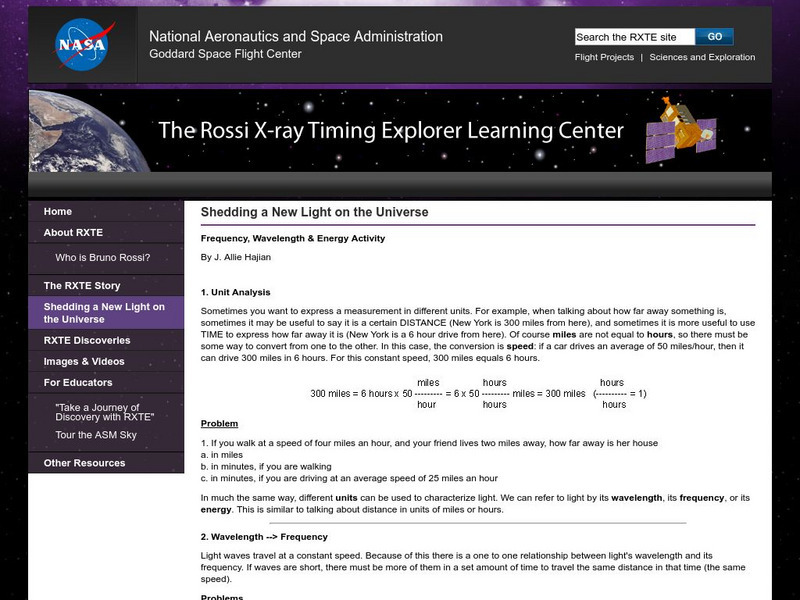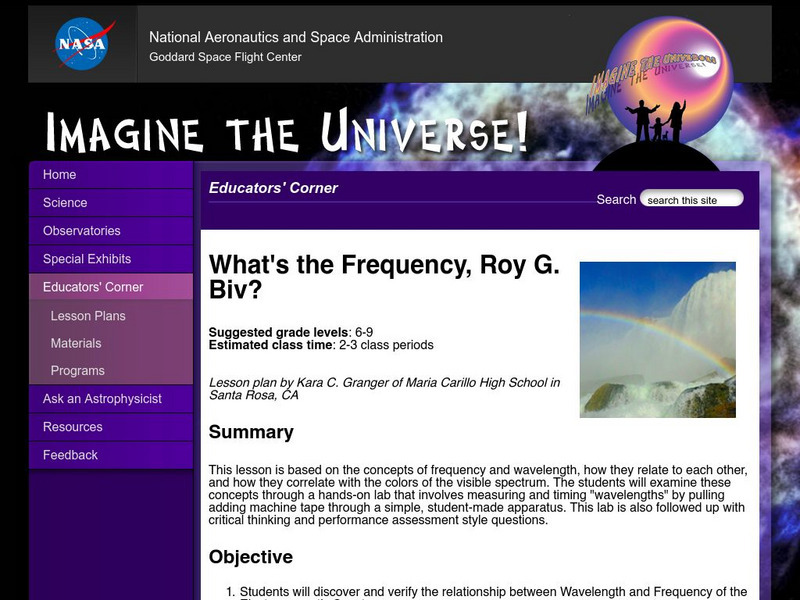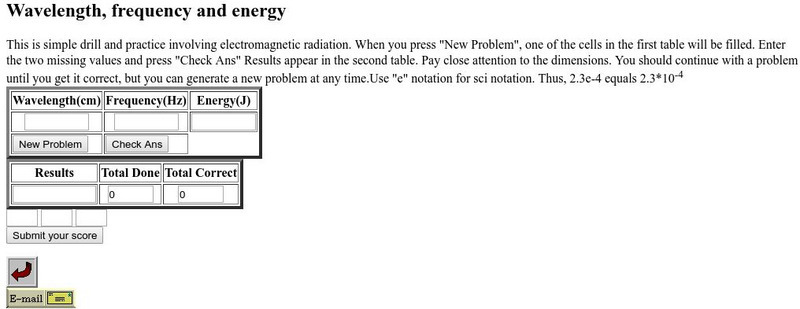Curated OER
Radio Astronomy and Radio Telescope
Students construct a simple radio telescope. In this astronomy lesson, students explain how this telescope works and what information it collects.
Curated OER
Stellar Fingerprints: the Spectra of Stars
Students explain how an element can be identified using emission spectra. They relate the emission spectrum of hydrogen to its absorption spectrum and identify hydrogen absorption lines in the spectrum of stars.
Curated OER
Understanding Symbols
In this symbols worksheet, students read about how different symbols are used to represent variables or constants in equations. Then students complete 3 problems.
Curated OER
Diversity: Using Light to Filter Prejudices
Students use physics to discuss diversity. In this social interaction activity, students use their knowledge of colors and filters to relate it to stereotyping and prejudices.
Curated OER
Waves
Students identify the different parts of a wave. In this physics lesson, students explain how animals communicate using sound waves. They discuss the effect of Navy's sonar on dolphins and whales.
Curated OER
A Look At Sunspots
Learners research how the development of new technology has increased our knowledge of how the sun works. This lesson is part of a three-part series aimed at showing students how our knowledge of the universe must be inferred through the...
Curated OER
Meteor Monitor
Student's measure sporadic meteor activity. In this physics and astronomy lesson, 11th graders construct a dipole antennae, and build, test and wire a full wave diode rectifier between the dipole antenna and the laptop.
Curated OER
Can You See the Music?
Fourth graders examine the makeup of the electromagnetic spectrum and how the various forms of EMRs are similar and different from each other. They, in pairs, solve problems from worksheets imbedded in this lesson plan.
Curated OER
Ways to See the Sun
Students examine how the regions of the Sun are studied using spectroscopy. They investigate the electromagnetic spectrum and the types of radiation that are associated with it. They use prisms and CD's to examine the light spectrum....
Curated OER
Scientific Images & Animations
Learners view a variety of scientific images and animations. They explore the world of science and visual art. Students enrich their knowledge through animation examinations of thoughts and feelings and awesome color rainbows of...
Curated OER
Planet Structure & Interior
Students compare Jupiter and Earth. In this Earth and space studies lesson, students compare the composition of Earth and Jupiter and analyze how the composition affects the rate at which the planets spin.
Curated OER
Sound Waves; vocabulary review
In this science learning exercise, students locate 28 words in a word search. The focus of the word search is vocabulary connected to the study of sound waves.
Curated OER
Jell-O Optics
Students observe an activity with Jell-O to learn about optics. In this investigative lesson students fill out a handout on the activity that helps them to investigate the index of refraction and the speed of light.
Curated OER
Investigation of Timbre
Students design an experiment to analyze the timbre of different instruments. In this physics lesson, students analyze the missing quality in sound. They discuss their results in class.
Open Curriculum
Open Curriculum: Frequency, Wavelength, and Pitch
To provide an overview of the relationship between frequency, wavelength, and pitch
Texas Education Agency
Texas Gateway: Physics of Hearing: Speed of Sound, Frequency, and Wavelength
By the end of this section, you will be able to define pitch; describe the relationship between the speed of sound, its frequency, and its wavelength; describe the effects on the speed of sound as it travels through various media; and...
NASA
Rxte Learning Center: Frequency, Wave Length, and Energy Activity
Resource focuses on the relationship between the frequency, wavelength and speed of light. Has a link to an interactive activity relating frequency, wavelength, and energy.
Physics Aviary
Physics Aviary: Wavelength Lab
This lab is designed to have students investigate the relationship between the speed of a wave, the frequency of the wave and the wavelength of the wave. Students can vary wave speed and frequency. Each of these should be varied while...
Utah Education Network
Uen: Wavelength and Energy
Students will calculate energy, frequency, or wavelength. After calculating, students graph their data and answer analysis questions.
NASA
Nasa: Imagine the Universe: What's the Frequency, Roy G. Biv
In this very detailed lesson plan from NASA, students investigate wavelength and frequency within the electromagnetic spectrum.
California State University
Electronic Homework: Wavelength, Frequency and Energy
Users solve computational problems concerning the wavelength, frequency, and energy relationships. Fill in the missing values and submit your answers to be corrected.
Florida State University
Florida State University: Basic Electromagnetic Wave Properties
This Florida State University page includes an interactive java tutorial that explores the relationship between frequency, wavelength, and energy, and enables the visitor to adjust the intensity of the radiation and to set the wave into...
Science Struck
Science Struck: Wavelength of Light
Describes the characteristics of light, presents two formulas for calculating its wavelength, and provides a table of the different wavelength ranges across the electromagnetic spectrum.
Khan Academy
Khan Academy: Calculating Frequency and Wavelength From Displacement Graphs
Practice using a displacement graph and wave speed to find the frequency and wavelength of a wave.





















